Bay is one of the three base colours horses can have, next to chestnut and black. It can be separated into three different types: wild bay, bay, and seal brown.
Bay-based horses can also be affected by modifiers and/or dilutions, resulting in various other different colours.
¶ Phenotype
A bay horse has a reddish coat with black points. These points are the outer edges of a horse: the mane, tail, lower legs and ear tips.
Bay horses come in many different shades. We can distinguish between three main "types": wild bay, bay, and seal brown.
- Wild bay is a lighter shade of bay. It can be recognised by the low black points: the black pigment barely reaches the pasterns. The coat, mane and tail are often also lighter.
- Bay horses have black points on their legs that go up to their knees and hocks. They have a reddish coat, and their shade can vary from a very light mahogany bay to blood bay.
- Seal brown is a darker shade of bay. They can sometimes be so dark that they resemble black horses. However, the soft parts of their body (muzzle, eyes, flanks, inside upper parts of legs) remain reddish in colour.
In Horse Reality, the shade of wild bay, bay or seal brown a horse gets once they turn into an adult is determined by chance (outside of the effect of modifiers).
| Bay Bases - Brumby Horse | ||

|

|

|
¶ Genotype
All bay horses have at least one dominant E (extension) and A (agouti) allele (E/_ A/_). The dominant extension allele makes the production of black pigment possible, while the dominant agouti allele is responsible for restricting the black pigment to the points of the horse only.
In real life, seal brown and wild bay were once believed to be caused by different agouti alleles. This theory has since been disproven, but in Horse Reality, three different dominant agouti alleles are still used to determine the colours: A+ (wild bay), A (bay) and At (seal brown). The order of dominance between the agouti alleles is A+ > A > At > a. The presence of dominant agouti can be tested at the Laboratory, but the wild bay (A+) and seal brown (At) alleles are hidden and not testable, meaning that their test results will be displayed as just A.
The table below shows all possible combinations of the alleles with their outcomes in-game:
|
|
A+ |
A |
At |
a |
|
A+ |
A+/A+ Wild bay |
A+/A Wild bay |
A+/At Wild bay |
A+/a Wild bay |
|
A |
A/A+ Wild bay |
A/A Bay |
A/At Bay |
A/a Bay |
|
At |
A+/At Wild bay |
A/At Bay |
At/At Seal brown |
At/a Seal brown |
|
a |
A+/a Wild bay |
A/a Bay |
At/a Seal brown |
a/a Black |
The current theory in real life is that E/E A/a generally causes dark shades of bay, with the phenotypes of E/E A/A, E/e A/A and E/e A/a being more variable from light-dark.
¶ Modifiers and dilutions
The following modifiers and/or dilutions can act on the bay base coat:
¶ Modifiers
Different modifiers can alter the phenotype of bay-based horses.
¶ Pangaré
Pangaré (PA), also sometimes referred to as mealy, is a modifier that only affects red pigment. It mainly lightens the areas above the muzzle and the eyes, and the underside of the body (flanks, belly).
Since the genetics behind pangaré are still unknown, it is not possible to test for the allele responsible for pangaré in-game. In Horse Reality, the allele causing the pangaré phenotype is dominant.
| Bay Pangaré - Brumby Horse | ||
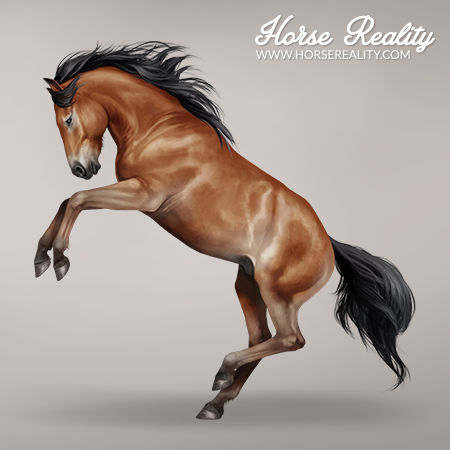
|

|

|
¶
Sooty
Sooty (STY, sty) or smutty is a modifier that causes a darkening of the coat that can be expressed in many different ways. It can often be characterised by a concentration of dark hairs mainly along the topline of the horse, which is called countershading. On some colours, such as wild bay, however, the dark hairs seem to be mostly on the lower part of the horse. Sooty can also cause very pronounced dappling on the coat.
Sooty bay horses can sometimes be hard to distinguish from seal brown horses. An important difference to note is that seal brown foals are born with their dark colouring, while sooty is a trait that increases with age.
In real life, the cause of the darkening coat has not yet been discovered. Therefore, sooty is not testable In-game. Its dominance can differ between breeds and coat colours.
| Sooty Bay - Arabian Horse | ||
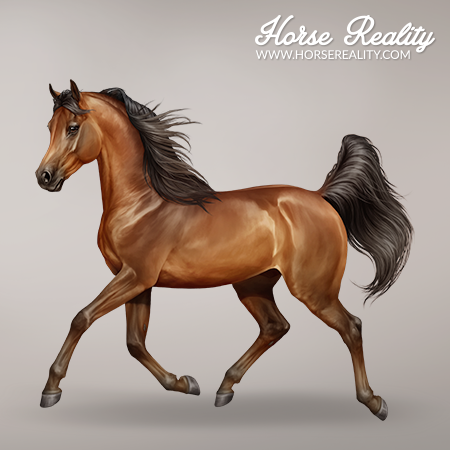
|

|

|
¶
Dilutions
Bay-based coats can be lightened when other dilution alleles are present, sometimes drastically altering the appearance of the coat and points.
¶ Cream and Pearl:
The cream and pearl alleles are located on the same gene. Cream is an incomplete dominant allele. Heterozygous cream (CR/n) dilutes the body to a tan, yellow or golden colour and has little to no effect on the black points. This colour is called buckskin. Homozygous cream (CR/CR) dilutes bay horses to a pale creamy colour called perlino.
Pearl is a recessive allele that also interacts with cream. Homozygous pearl (prl/prl) dilutes bay horses to a golden colour with tan or light brown mane, tail, and feathers with mottled skin. CR/prl creates a lighter colour, more similar to homozygous cream.
| Bay + Cream and Pearl - Pura Raza Española | |
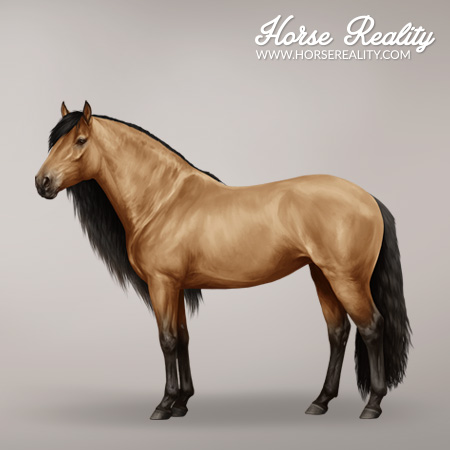
Bay + CR/n |
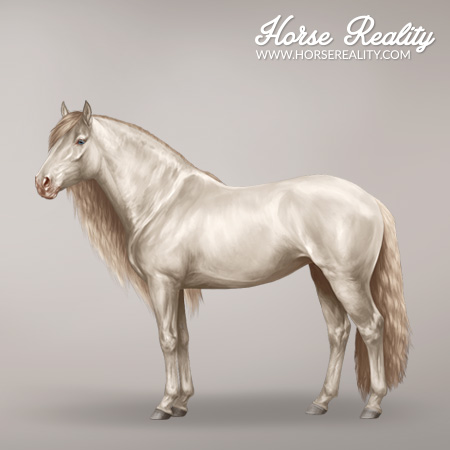
Bay + CR/CR |
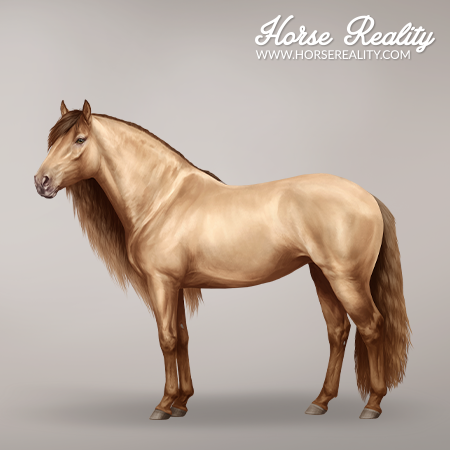
Bay + prl/prl |
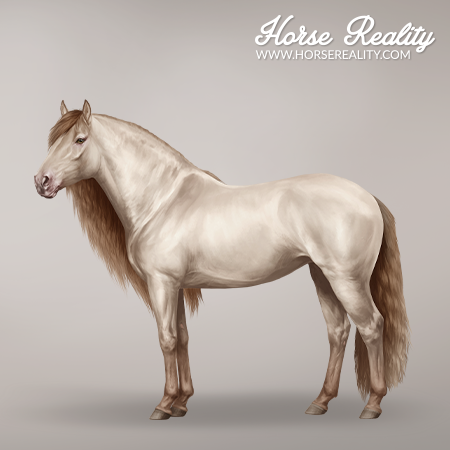
Bay + CR/prl |
¶ Dun
The dominant dun allele (D) both dilutes and creates primitive markings (dorsal, leg stripes, etc.) on the coat. Black dun horses are also often called grulla or grullo. Non-dun 1 (nd1) is a mutation on the same gene that causes primitive markings, without the dilution effect. When heterozygous cream (CR/n) and dun are both present, the colour is often called dunskin.
| Bay + Dun - Irish Cob Horse | |
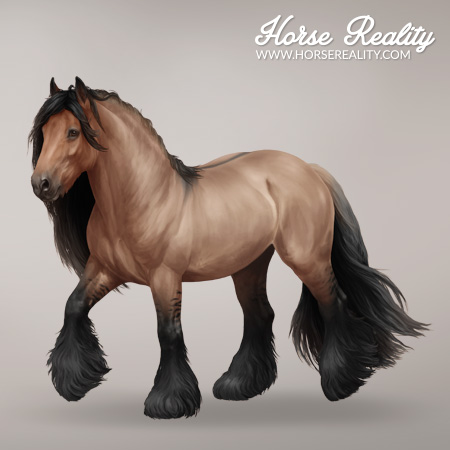
Bay + D/D, D/nd1, or D/nd2 |

Seal brown + D/D, D/nd1, or D/nd2 |
| Bay + Non-dun1 - Namib Desert Horse | ||

Wild bay + nd1/nd1 or nd1/nd2 |
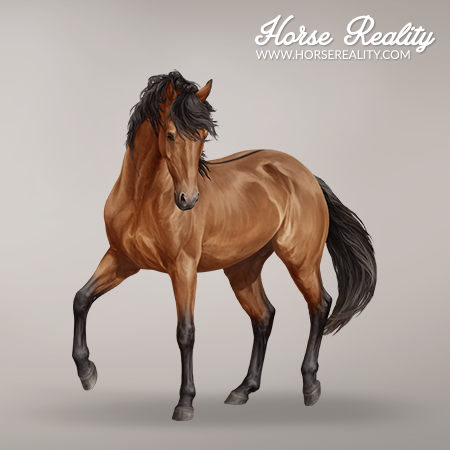
Bay + nd1/nd1 or nd1/nd2 |
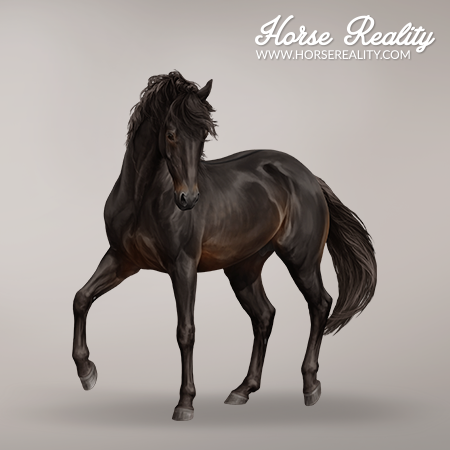
Seal brown + nd1/nd1 or nd1/nd2 |
¶ Champagne
Champagne (CH) is a dominant allele that dilutes bay horses to a pale brown colour with darker points, with a tint that can be described as lilac. The skin is mottled and the eyes have an amber-like colour. Bay horses with champagne are called amber champagne. Champagne on a seal brown base is called sable champagne. When heterozygous cream (CR/n) is present, the colour is called amber cream and sable cream respectively.
| Bay + Champagne - Quarter Horse | ||
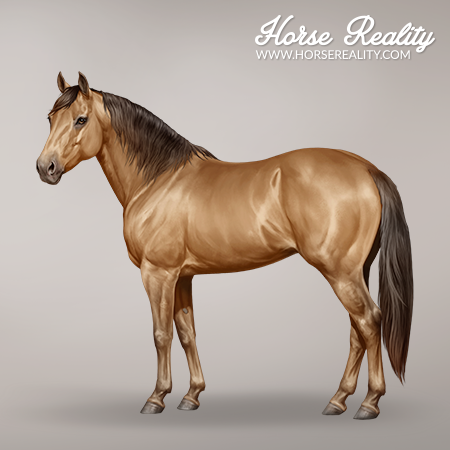
Wild bay + CH/CH or CH/ch |
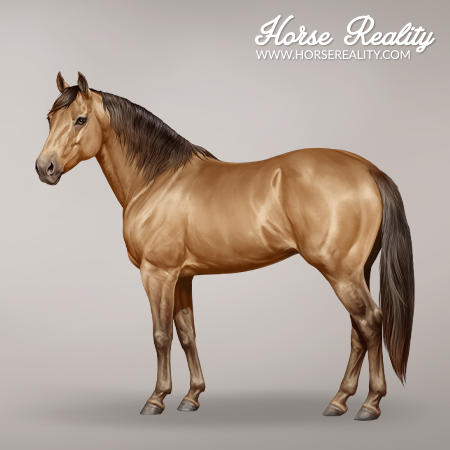
Bay + CH/CH or CH/ch |
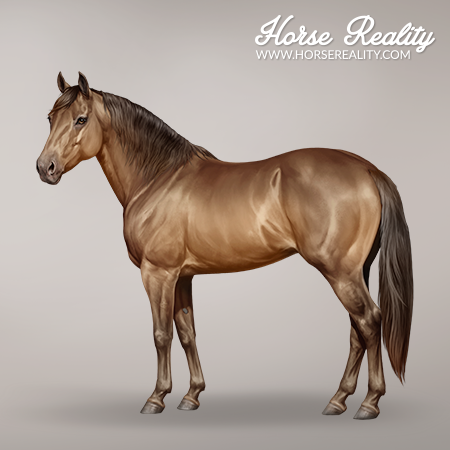
Seal brown + CH/CH or CH/ch |
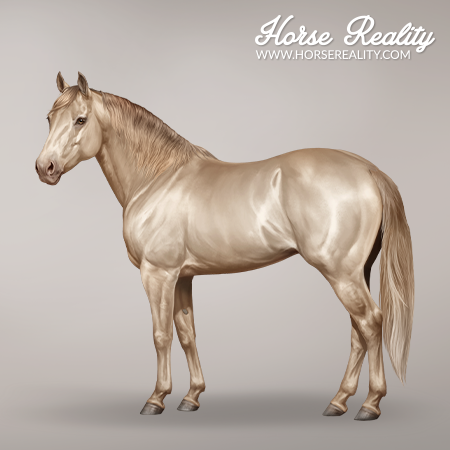
Wild bay + CR/n + CH/CH or CH/ch |

Bay + CR/n + CH/CH or CH/ch |

Seal brown + CR/n + CH/CH or CH/ch |
¶ Silver
The Silver (Z) mutation, also called silver dapple or taffy, affects black pigment only. Mane, tail and feathers of bay horses get diluted, while their bodies are unaffected. Silver seal brown horses may have a slightly diluted body, similar to silver black horses.
| Bay + Silver - Finnhorse | |
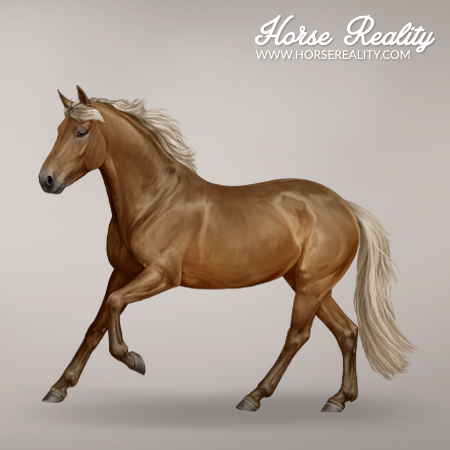
Bay + Z/Z or Z/z |
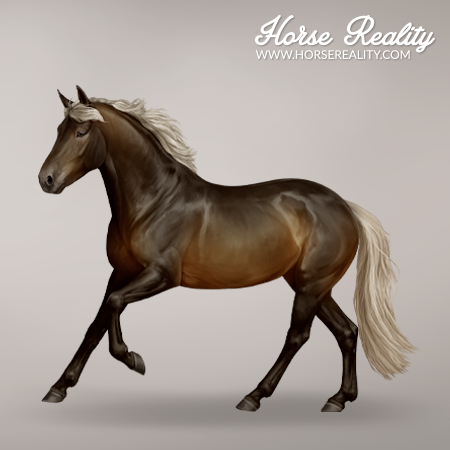
Seal brown + Z/Z or Z/z |
¶ Breeds
Bay is a common colour in many horse breeds. The following table lists all breeds that can currently have the dominant extension (E) and agouti (A) allele in-game. Note that it only lists breeds that carry the “standard” bay allele, A. For information on which breeds can be wild bay or seal brown, please visit their respective pages.
| Breeds |
| Akhal-Teke Horse |
| Arabian Horse |
| Brabant Horse |
| Brumby Horse |
| Camargue Horse |
| Cleveland Bay |
| Exmoor Horse |
| Finnhorse |
| Fjord Horse |
| Friesian Horse |
| Haflinger Horse |
| Icelandic Horse |
| Irish Cob Horse |
| Kladruber Horse |
| Knabstrupper |
| Lipizzaner Horse |
| Lusitano |
| Mongolian Horse |
| Mustang Horse |
| Namib Desert Horse |
| Noriker Horse |
| Norman Cob |
| Oldenburg Horse |
| Pantaneiro Horse |
| Pura Raza Española |
| Quarter Horse |
| Shetland Pony |
| Shire Horse |
| Suffolk Punch |
| Thoroughbred |
| Trakehner Horse |
| Welsh Pony |
¶ References
- Bellone R., Sponenberg D. P., Equine Color Genetics, 4th Edition, 2017, Wiley-Blackwell
- UC Davis Veterinary Genetics Laboratory; https://vgl.ucdavis.edu/test/red-factor-horse and https://vgl.ucdavis.edu/test/agouti-horse; Access: November 2022
- Generatio Center for Animal Genetics; https://generatio.de/en/knowledge/basic-genetics/coat-colours-horse, https://generatio.de/en/guidance/lexicon/extension-chestnut-base-colour-e-locus-horse and https://generatio.de/en/guidance/lexicon/agouti-bayblack-base-colour-locus-horse; Access: November 2022